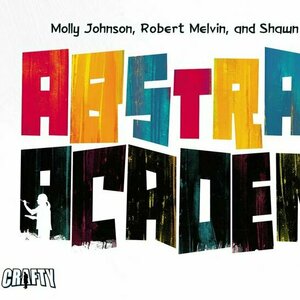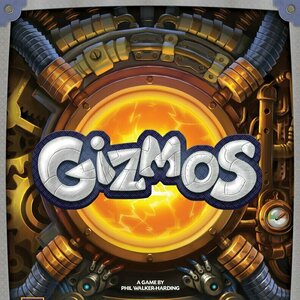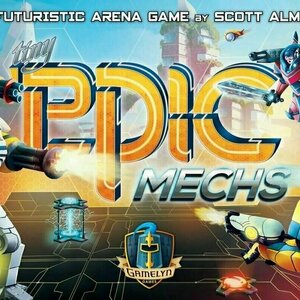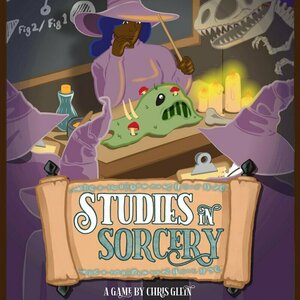
Abstract Academy
Tabletop Game
At the Abstract Academy, competition is fierce. You and your fellow art students vie for top marks...
Purple Phoenix Games (2266 KP) rated Gizmos in Tabletop Games
Apr 20, 2021
Gizmos is a card drafting, energy collecting, engine building game about, well, building engines. Players will be attempting to draft machine parts from an offer pyramid and build them onto their master jalopy machine using energy marbles in order to chain actions together and maximize their turns. The victorious player is they that claims the most VP from cards and bonus VP tokens at the end of the game.
To setup, assemble the energy dispenser (the marble gumball machine looking component) and place it on the table. Fill it with all the marbles and marvel at the first six that come out into a chute display. Separate and shuffle the card decks by their backs and set out four cards of level I, three cards of level II and two cards of level III. Determine starting player and give them the starting tableau board. Each player will receive a tableau board, an energy ring, and a starting gizmo to be placed under the File section of their board. The game may now begin!
On a player’s turn they will be completing one action from the four actions printed on their player board: File, Pick, Build, and Research. The File action is used when a player chooses a card from the gizmo pyramid (from any level) and places it in their Archive – an imaginary area to the right (or even above I’ve found) their player board. At the beginning of the game players will be able to hold just one gizmo in their Archive, but as they draft and build Upgrades, this number can increase. When choosing the Pick action, the player will simply choose one of the energy marbles from the dispenser chute and place them in their energy ring. Initially rings are only able to hold five marbles, but this also can be increased on future builds. To Build a gizmo into a player’s machine, the player will spend a specific color and number of energy marbles printed on the chosen gizmo card to place the card into their player tableau. These gizmos could possibly be Upgrades, energy Converters, or upgrades to the File, Pick, and Build actions. Pay the energy marble to the dispenser supply. Players will choose to Research when they do not like the gizmos on display in the gizmo pyramid. Researching allows players to draw the top cards from any face-down level deck and choose one to either File or Build.
The game is super simple to this point, but this is where the true strategy and tactics come into play. Though there will always be nine gizmos on display during a player’s turn, the value of these gizmos are in how they are used in the player tableau. Yes each gizmo allows for some benefit, but successful players will be able to utilize these benefits to create chain reactions. When an action is spent to do a thing, gizmos in play in the tableau will sometimes link to the action, or to the placement of a certain type of card, or a certain energy type (color) of gizmo built. It is mastering these chain reactions that creates next-level strategizing and separates the players from the champions. Play continues on in this fashion until a player has built their fourth level III gizmo or their 16th gizmo in total. Count up VP from built gizmos and bonus tokens earned from built gizmos throughout the game to see who wins the science fair (is that what happens at science fairs? People win those, right?)!
Components. So the gizmo cards are fine, and the cardboard components are fine as well. The marbles are interesting and bubbled plastic (or resin, I told you I’m not great at science) and come in great colors. The true star component here is that energy marble dispenser. It is absolutely brilliant. The game comes with assembly instructions, thankfully, but once it’s built, it’s built forever. It packs neatly back into the box, and the insert is very very well done. The artwork on this is surprisingly secondary to me. In fact, I don’t really remember even looking at much of the artwork on the gizmo cards as I was playing because I concentrate so much more on the effects of the gizmos and trying to figure out my next move to really sit and gawk at the art. The iconography takes a little time to get used to, but once you have seen it in action for a few rounds, you catch on quickly. All in all, a fine set of components, but with the insert and dispenser, now a great set of components.
I adore this game! I love engine builders, and the chain reactions you can create with your gizmos are excellent and can be very powerful. You can try to generate tons of bonus VP from your gizmos, or concentrate on versatile energy marbles using a bunch of Converters, or simply go guns blazing on everything you can afford to try to blitz to 16 gizmos built. Whatever your play style, Gizmos can certainly allow you to play your way while giving you choices upon choices to make each turn.
With all these positives, I had to find a negative, right? Well, ok, yes, but it’s super minor to me here. I don’t really feel like the theme is very immersive. Not once have I felt like I am building a machine in order to win a science fair, but I do feel like I need to maximize my turn every time in order to grab more energy, or to build better Upgrades and Converters so I can grab any gizmo I want and build it right away. So, theme is there, but not at all strong.
Though the theme is just okay, the game play certainly is stellar. This one has everything I like in an engine building game, and has unique and interesting components. Would I like it more if the theme was different. I doubt it. The game play is just so good that the theme and artwork takes a back seat for me, and that’s super weird for me to type. Should you be looking for a great engine building game that looks awesome on the table, has cool components, and allows you to play differently every game, then go find yourself a copy of Gizmos. Purple Phoenix Games gives it an energetic 21 / 24. Now if only my 4-year-old could keep the energy marbles in the chute or the ring and not on the floor…
Purple Phoenix Games (2266 KP) rated Pirate's Mark in Tabletop Games
Mar 29, 2021
Pirate’s Mark is a bluffing, bidding, press-your-luck card game about finding treasure in the sea and avoiding contracting the Pirate’s Mark: the mark of death. In it players are pirates searching the seas by boasting about how many treasures they expect they will find, flipping over cards, and dealing with any consequences of their pulls. The last pirate to remain unmarked at the end of the game will be the winner and richest of all pirates on the vast seas.
DISCLAIMER: We were provided a copy of this game for the purposes of this review. This is a retail copy of the game, so what you see in these photos is exactly what would be received in your box. I do not intend to cover every single rule included in the rulebook, but will describe the overall game flow and major rule set so that our readers may get a sense of how the game plays. For more in depth rules, you may purchase a copy online or from your FLGS. -T
To setup, include the correct number of cards as described in the rulebook for the number of players. Once the cards are shuffled they will be laid out in a 10 x 15 grid on the table, face-down. The Compass Rose card and die are placed near the card grid and the game is ready to begin!
On a turn a short bidding round commences with players announcing how many cards they believe they can pull from the grid without uncovering a Pirate’s Mark card. This bidding goes around the table with bids increasing with each player until one player calls the bluff and forces the last player to bid to take their turn. That player then pulls a number of cards face-up from the sea and resolves any cards that are immediate, stashes cards that are treasures, and holds cards that contain the phrase, “Play this card,” to be used at a later time.
If the turn is uneventful, by not revealing any Pirate’s Mark cards, then the game continues with bidding and pulling. However, once a pirate reveals a Pirate’s Mark card, they are marked and cannot participate in the bidding any longer (unless they find a way to unmark themselves, which IS possible). Marked players can get back in the game by calling another player’s bluff correctly. There is indeed risk here as a marked player that incorrectly calls a bluff is permanently dead and out of the game.
There are some more rules for the end of the game phase called, “Duel Mode,” but I will let you discover those on your own. Play continues in this fashion until one player is standing and unmarked. This player wins the game and the others need to pack up the 130 cards that were setup. Okay, I added that last part.
Components. This game is a ton of square cards and a fantastic d12 that is only used for the two-player variant. The cards are all glossy, but good quality, and feature photos (akin to screencaps from movies) instead of illustrations. I find the theme to be very present in not only the press-your-luck and bidding/bluffing mechanics, but also in the design of the cards and the photos used. It feels like a piratey game and plays like a piratey game. Like I said, the d12 is fabulous, and I actually happen to own a set of dice that I use for my RPG campaigns… sometimes. All in all the game has some good components and looks great on the table.
So I have some good AND bad news to deliver. First the bad. Some cards that are pulled are way too overpowered. One is called “Blackbeard’s Sword.” It allows the player to “peek under the number of cards left in your bid.” I used this card on a bid of 22 cards and was able to pull all safe cards because this allowed me to see 22 cards and avoid any Pirate’s Marks. Super OP if you ask me. The only other bad I have here is setup. There are 130 cards to be sorted, shuffled, and laid out in a nice-looking grid before the game can be played. For those of us with slight or full-blown OCD that is a nightmare. Luckily, I only stress if the cards are way out of whack instead of just slightly askew.
Now for all the good. I like this game quite a bit. To offset some of the OP of the aforementioned card, the game comes with some pretty great Lucky and Curse cards to be pulled. A couple Lucky cards are, “Drop Anchor,” which ends the player’s turn when revealed, thus negating any Mark pulls, and “Flying Dutchman,” which can be played on a marked player to instantly kill them. Now, I do not condone murder normally, but when playing a pirate game, it is to be expected. The Curses pulled are equally unlucky. “Winds of Fate” allows the person who called the bluff to choose the rest of the cards to be pulled for your turn. OUCH! Especially if they had used “Blackbeard’s Sword” and know where one or more Pirate’s Marks are hidden. Similarly unlucky is “Isla Muerta” which penalizes the player if they have 10 or more treasure cards and pull a Pirate’s Mark – they die instantly from the curse! These are just a few examples of some cards that can be encountered during play, and there are a whole lot more of them included.
I do so enjoy bluffing and luck-based games more and more, and Pirate’s Mark certainly gives it to me on those fronts. Being able to just whisk away 20 or more cards because you happen to have that coveted card you used is devilishly fun. Watching the other players seethe with envy as you pull treasure after treasure and avoid Marks is like winning $20 on a scratch-off. It won’t change your life, but it will give a shot of adrenaline and euphoria for a few minutes. I think Pirate’s Mark fills a void of straight bidding, bluffing, and luck that certainly matches the theme perfectly, and remains a good game as well.
Also, if you happen across one of the expansions, “Parrghty Mode,” it adds another five players to the game and bumps up the count of cards in play from 130 to a whopping 168! This is not for the small of table. I wish there was room inside the base game’s box to fit these extra cards, but alas, there is not.
So if you are like me and enjoy games on the lighter side that perfectly match game to theme, then you have to check out Pirate’s Mark. Purple Phoenix Games gives this one a haunting 8 / 12. I certainly recommend it and will now be finding a place in my main shelf unit for it. Hmm, which game do I make walk the plank…?
Purple Phoenix Games (2266 KP) rated Tiny Epic Mechs in Tabletop Games
Jun 30, 2021
Disclaimer: I do not intend to rehash the entire rulebook in this review, but give a general overview of turns and gameplay. For a more in-depth look at the rules, pick up a copy of the game from the publisher or your FLGS! -L
Tiny Epic Mechs is a game of action programming in which players take on the roles of Mech pilots competing in an arena-style battle royale event. Through the purchase of new weapons, powering up into Mech suits, combat with opponents (either face-to-face, or through the deployment of mines and turrets), and controlling different zones of the arena, players are trying to earn the most Victory Points by the end of 6 rounds of play. To begin, follow the setup instructions for the arena, based on the player count. Each player receives a player card (to track resources, and also acts as a reference card), a Pilot card, components in their chosen player color, and 1 Basic Weapon card to equip on their Pilot. Set the Round Tracker to round 1, create a market row of Advanced Weapons, place the Mighty Mech suit on it’s corresponding zone card, and the game is ready to begin!
Each round consists of 3 phases: Program, Execution, and Scoring. During the Program phase, players will secretly choose 4 Program Cards from their hand to represent their 4 moves/actions for this round. The chosen Program Cards will be laid out in order above the player card, and will immediately be covered by a face-down unused Program Card. (There are 8 Program Cards total, only 4 of which are used each round). It is important to note that the orientation of the Program Cards matters – Program Cards must be played parallel to the zone cards of the arena. Since they dictate the directions in which you move, you must place them exactly as you want to move. During the second phase, Execution, players will take turns revealing their Program Cards, one at a time and in order, and resolving the actions. To Execute a Program Card, you will first move your Pilot in the direction of the card’s arrow, and then resolve the action listed on the card. Movement is a must and cannot be skipped.
After Movement, you may perform the action on your card – Collect Resources, Purchase a Weapon, Deploy a Mine or a Turret, or Power Up. The first three of these are pretty self-explanatory. The Power Up action allows your Pilot to either heal themselves or upgrade into a Mech suit. Now to discuss crux of the game – combat. During the Execution phase, if you enter into the same zone as another player, you must immediately begin Combat. You will use your equipped weapons to battle your opponent, in hopes of knocking them out or forcing them to retreat. Weapons will deal base damage, or Power Attack damage, based on the circumstances of the combat. To attack with a weapon, you will deal the base damage immediately to your opponent. After your attack, the weapon you used is Exhausted and cannot be used again this combat. Your opponent then has the chance to attack back – either regularly or via Power Attack (I’ll leave that for you to discover on your own). Combat continues, alternating between players, until either a player is KO’d, or is forced to retreat because all of their weapons have been Exhausted. Initiating combat, dealing damage, and defeating your opponent all earn you VP, so combat is a vital part of the game!
After all players have revealed and performed their final Program Card, the round ends. At the end of the 2nd, 4th, and 6th round, players will perform a Scoring phase, earning points for any zones occupied by their own mines, turrets, or Pilot. At the end of the 6th and final round, scoring takes place as stated above, but players will also earn VP for all weapons they have purchased throughout the game. The player with the highest VP is the winner!
I have to admit that I am not a person who generally enjoys the mechanic of action programming. I like to really think through my strategy, and execute it exactly as I want. Action programming makes strategizing more difficult because your success or failure depends on the actions selected in advance by your opponents. You can’t really adapt mid-round, you kind of just have to deal with what’s happening. That being said, Tiny Epic Mechs, in my opinion, has a good balance of combat and actions/resource management. Your entire strategy can’t be based on combat – you need to upgrade weapons, climb into your Mech suit, etc. – and the ability to vary combat with individual upgrades makes the gameplay feel more strategic. Yes, your opponents might still mess up some of your best-laid plans, but you have to be prepared for any situation.
The overall gameplay can feel calculated or chaotic simply based on the player count. In a 2-player game, obviously there are only 2 people, and you have more opportunities to really focus on your individual Pilot before necessarily traipsing into combat. In a game with 3 or 4 players, interactions between players are inevitable and can really make the action programming mechanic stand out/feel more random/etc. Especially with a small play arena, Pilots will be crossing paths at probably every turn, and you may be forced into more combats that you anticipated. With only 2 players, there are interactions between players, but it feels a little more calm overall, and you can really work with a strategy instead of having to adapt to sudden changes in the arena.
Let’s touch on components for a minute. As always, this Tiny Epic delivers on quality components. The cards are colorful and sturdy, the text easy to read. The wooden components for tracking health/resources are good, but maybe just a little too small, even for my regularly-sized hands. The ITEMeeples, Mech suits, and weapons are always fun to play with, and sturdy enough to hold up to lots of plays. All in all, great work from Gamelyn Games once again.
For being a game of action programming, I have to admit that I enjoyed Tiny Epic Mechs more than I thought I would. At least at a 2-player count. Anything more feels too chaotic and random to me. The elements of programming and combat are engaging and elevate the gameplay, but it’s just not my favorite mechanic. Will I keep this game? Definitely. For what it is, I think it does a good job. Will I get more action programming games in the future? Probably not. I’d say Tiny Epic Mechs fills that spot for me, and that is all good in my book. Check this one out if you’re looking for something fun and relatively simple that utilizes this mechanic. Purple Phoenix Games gives it a mechanical 7 / 12.
Purple Phoenix Games (2266 KP) rated Studies in Sorcery in Tabletop Games
Oct 6, 2020
Studies in Sorcery is a competitive card game that uses elements from other well-loved games and puts them with a wonderful theme and some very interesting card synergies. The game takes place over four school semesters (rounds) and each semester lasts four weeks (turns). Can you students complete your thesis using the research grants you are given, or will you fall flat to repeat the program again?
DISCLAIMER: We were provided a prototype copy of this game for the purposes of this preview. These are preview copy components, and the final components may be different from these shown. Also, it is not my intention to detail every rule in the game, but to give our readers an idea of how the game plays. You are invited to back the game on Kickstarter launching October 6, 2020, order from your FLGS, or purchase through any retailers stocking it after it is fulfilled. -T
To setup, separate each deck of cards into like piles (Levels 100, 200, and 300 of the projects, graveyard cards, candles, vials) and shuffle them. Lay out the moon phase cards and semester tracker, placing the tracker tokens (skull erasers in the prototype) on the start of the cards to begin play. Set out the candles and vials in their own piles, as well as the point modifier tokens. Deal project cards according to the semester tracker in a 3×2 pattern under the moon phase and semester tracker cards like is shown in the photo below. Initially the graveyard pile will have three stacks of two cards each face-down next to the draw pile. Each player receives a research grant card, two thesis cards to choose one from, and two 100-level project cards from which the player will choose one. Give the first-player token (in this prototype it’s a cute LEGO skeleton) to the player who last attended school, and the game may begin!
Each player will be resolving actions, committing materials to their projects, and using completed project abilities each moon phase (turn). The actions one may take are: Dig, Buy, Cram, and Project Action. When a player uses the Dig action, they are searching for materials. A player can look at the items in the first pile of graveyard cards and take all the contents. If they do not like them, draw a card from the draw deck and place it on the first pile. Continue this for the next pile, and if unsatisfied the player may draw the top card from the draw pile OR either a candle or vial from the supply of stock cards.
Buy actions allow a player to use any unwanted materials or research grant monies to purchase additional candles, vials, or project cards from the middle of the table. To Cram, players may commit up to two materials from their hand to a project by placing the materials under the project cards. Project Actions allow players to use actions printed on any of their completed project cards. These can be very powerful.
Once each player has taken one of these actions, move the tracker token on the moon phase card to the next icon – Commit. To commit materials to projects, simply place the cards under the selected project (exactly like players do with the Cram action). Once all players have completed their commits, they may complete any projects that have sufficient materials by discarding the used materials and flipping the project card to its opposite side earning the printed points at the end of the game.
Play continues in this fashion for four turns each semester and the game lasts four semesters. Therefore the game will last 16 turns total. Whomever earns the most points for combinations of completed thesis cards, completed projects, bonus point modifier tokens, and one point for each $8 worth of materials in hand will be named Valedictorian of their class and winner of Studies in Sorcery!
Components. Again, this is a prototype copy of the game, and I know some things will be different in the final version. However, what we were provided is a bunch of cards that have great art, are good quality, and are very easy to read and understand. The cute first player token will more than likely become a different component in the end, and the tracker tokens probably will be changed as well, but these are great bits to include in a game like this. The only negative I have about components is that I wish there was MORE color. Most of the cards are brown-heavy, and it’s completely fine, but I would love to have splashes of weird colors here and there. Overall, I am very pleased with the components in this game. Weird Giraffe Games always has great components in their prototypes AND final games.
It is probably no surprise that I love this game. The theme is wonderful, the wonky art is great, and it’s more thinky than one might imagine. The game play can be somewhat quick, or players can take excruciating amounts of time to think through their turns and chain together impressive actions. One thing remains constant – 16 turns to complete your thesis cards can be a huge undertaking. My first time playing I chose a thesis card worth 7 points (even though the rulebook advised me not to include those for the first play). I wasn’t even really that close to completing the thesis, but I may have with another two or three turns. But then again, that card is worth 7 points for a reason – it’s SUPPOSED to be difficult. My suggestion: take the rulebook’s advice and remove those thesis cards for the first play. Don’t try to be a hero.
Ahhhhhhh! I want to play it again right now just so I can attempt that thesis card again. But there are other thesis cards in the game. And other strategies to apply. And really, when you can’t wait to play a game, that’s a sign of a fantastic game for that specific gamer. Will this be a gem for everyone? I don’t know. It certainly works for me and my circle of gamers.
If you are a fan of the Harry Potter series (even though this is NOT a Harry Potter game) and need a thinky card game with that sort of fantasy classroom theme, or if your collection is begging for something new and quirky, or if you just love Weird Giraffe Games’ catalog and need every game they offer (I wouldn’t blame you), then you need to give Studies in Sorcery a look. Please consider backing it on Kickstarter launching October 6, 2020. I know my collection just got a lot cooler with this one.

The Secret Language of Sacred Spaces: Decoding Churches, Cathedrals, Temples, Mosques and Other Places of Worship Around the World
Book
From Stonehenge to the Sagrada Familia, from the Acropolis to Angkor Wat, human beings have directed...

Global Dynamics of the Earth: Applications of Viscoelastic Relaxation Theory to Solid-Earth and Planetary Geophysics: 2016
Roberto Sabadini, Bert Vermeersen and Gabriele Cambiotti
Book
This volume opens up new perspectives on the physics of the Earth's interior and planetary bodies...

Wedding Planning Podcast | Your Online Wedding Planner | Free Advice from Engagement to Wedding Day from Kara Lamerato of KVW
Podcast
The Wedding Planning Podcast is your go-to source for fresh wedding planning advice, delivered THREE...

The Best Homemade Kids' Lunches on the Planet: Make Lunches Your Kids Will Love with More Than 200 Deliciously Nutritious Meal Ideas
Book
We all know that kids need to eat right and get the nutrition they need to be their best all day...

SkySafari 4 Plus: Map the Universe! Discover Sun, Moon, Mars, Stars, Planets, and Satellites with your telescope and NASA space missions!
Reference and Education
App
***SkySafari has been upgraded! For more information on the NEW SkySafari 5 Plus for iOS, visit...



